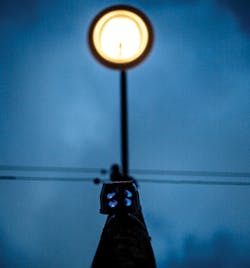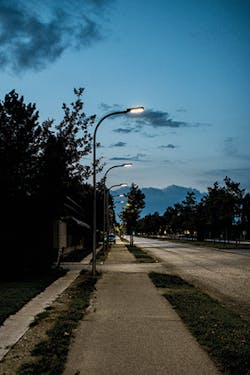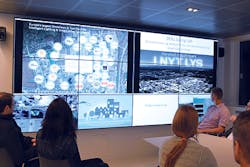LED technology brings cost savings to street lighting, but CAROLINE HAYES explores how DOLL (Danish Outdoor Lighting Lab) takes street lighting even further with projects to demonstrate how it can contribute to the creation of smart cities.
DOLL (Danish Outdoor Lighting Lab) is a consortium of three partners: Gate 21, a partnership of local authorities, private companies, and research institutions; the Technical University of Denmark (DTU); and the municipality of Albertslund.
It is made up of three laboratories. The Quality Lab and the Virtual Lab are both located at the DTU's Photonics department; and the third, the Living Lab, is in the Hersted Industrial Park, Albertslund, a suburb of Copenhagen. The Living Lab opened in September 2014, as part of the "City under the Microscope," at the LUCI (Lighting Urban City International) conference. During the conference week, visitors toured the area, which has a 1:1 scale "living" installation of 50 different product types from 28 companies. The area of approximately 2 km2, with 9 km of roads and pathways, has smaller sections - measuring about 300m2 - where each company can demonstrate what different LED and luminaire types and designs can bring to urban environments (Fig. 1).
Related article: Intelligent lighting paves the way for the smart city
For example, Thorn Lighting has installed its Adelie Sun energy-efficient luminaire in the entrance of the DOLL offices. It is powered completely by solar panels in the top of the luminaire rather than integrated into the column. The energy-efficient version of the company's Adelie luminaire was designed by Morten Lyhne, and can be placed on any mast without the need to be connected to electricity.
Other areas have Thorn's Avenue D2 LED and Plurio O LED luminaires for creative lighting on paths and parks; the Oxane L LED demonstrates light control in another area; and security in residential areas is demonstrated in another with the Christian IV and EyeKon LEDs.
Light management
Thorn partnered with Paradox Engineering to use its PE.AMI smart lighting management platform to change lighting scenarios, with dimming and controls.
The IPv6/6LoWPAN management system allows each luminaire to become part of a network. Each can be monitored and controlled, and used for data transmission, for example, monitoring temperature. It anticipates the Internet of Things (IoT), where devices are connected over the Internet, and smart cities where data can be used not only for smart lighting but also for smart parking, metering, or traffic flows.
Related article: Smart lighting track illuminates connected lighting
"Who will own the agenda for the smart city?" asked Flemming Madsen, head of secretariat, DOLL. "It may be the power grid, or the heating system, which demands to have intelligent meters for remote readings," he suggested, "but lighting is central. It is everywhere in the urban infrastructure. The network with the most nodes will be the winning network - and that is lighting," he concluded.
One aim is for the lighting in the project to be carbon neutral, said Madsen, explaining the presence of solar energy and wind turbines in some areas. Of the 12 lamp posts with solar panels and the two wind turbine installations, he said, "These are experiments to see if lamps that are only powered by solar [or wind] energy work most of the time."
Kim Brostrøm, CTO, DOLL, believes Denmark has some of the strictest lighting regulations in the whole of the EU. If a lighting scheme meets Danish regulations, he said, it will be acceptable in most places. The capital city, Copenhagen, has just signed a contract with France's Citelum to replace and renew over 21,000 outdoor lighting points with LED lamps, over a period of 10 years. Each will have an IP address and half of them will have extended sensor capacity, noted Madsen, who proclaimed, "Copenhagen will run a smart city through lighting." Looking ahead, he believes that intelligent traffic management systems will be introduced based on real-time measurement of traffic density.
Smart city networks
Brostrøm agrees that the way forward lies in using the existing lighting infrastructure as the backbone for the smart city. DOLL partner Cisco uses the Living Lab to test Wi-Fi in public areas. "The idea is to connect different sensors to a common infrastructure [to create smart cities]," he said. Placing RF or ZigBee devices within the posts will control groups of luminaires and also provide data for central management. For example, Brostrøm cites the maintenance of rainwater drains. For local authorities to inspect drains annually is expensive, especially as few have material in them that needs to be cleared at any one time, he said. "Sensors could advise if a drain needs to be cleaned and which can be left, using the lamp post as the carrier infrastructure.
"Technology is changing," continued Brostrøm. "Every light post will have its own IP address and be connected, so it is not just a lighting system but an IT system." This will enable remote monitoring, for example, to test luminaires that dim if the weather gets sunnier, or brighten when people pass by it during night hours. It also means that it can alert a central municipal control center if a bulb is not working for more efficient, targeted maintenance.
Related article: SIL speaker addresses smart lighting and safety within the Internet of Things
Another example currently being demonstrated and tested at DOLL are street lamps from Dutch company Tvilight, which adjust brightness based on movement. Sensors that track traffic density, noise, air quality, weather conditions, and ultraviolet (UV) radiation will be fitted throughout the site, and the results monitored in the central control room to assess the degrees of lower costs and emissions that can be achieved.
Madsen noted, "More manufacturers are implementing sensors in luminaires; it is not an extra cost to mount a sensor on a mast anymore, it is combined in the luminaire."
Living space
The Living Lab area is more than an extravagant showroom for international companies such as Thorn Lighting, Osram, Philips, Sparkle, and Zumtobel, as well as lighting designers. It also demonstrates performance in various controlled conditions - for instance, reflection on wet and dry asphalt, brighter lighting in heavy traffic areas, and warmer hues for garden or park areas. International delegates and local authority representatives can visit to see how configurations work in different lighting systems as well as to compare the energy efficiencies using the Quality Lab, which tests and characterizes light sources, fixtures, lamps, and lighting components.
The third element, the Virtual Lab, allows manufacturers to model and test lighting solutions in 3D, but also creates a virtual model of a square or a street to test the lighting effect. For example, lamp designs can be instantly changed or the distance between posts can be altered along a stretch of path on the virtual model, to see what effect these changes may bring about in the Living Lab.
Brostrøm said the aims of DOLL are to introduce new lighting solutions, adapt LED lighting, and to create transparency in the market. The control room and visitor center play an important role in this (Fig. 2). Here the different management systems can be seen in operation, not just from the street. It also provides an idea of the total cost of ownership. "Visitors can assess service, maintenance, longevity, and cost," he said.
"The aim of DOLL is to offer and influence luminaires and management systems," added Madsen. Delegations have already visited from Taiwan, Korea, and Japan. "Already, DOLL is influencing the choice of 300,000 street lamps in Danish municipalities, and 20 municipalities have based decisions on a DOLL visit and using DOLL as a partner."
The project, funded by the Danish Government and regions, is already expected to be expanded. The municipality has given another 4 km of streets, says Brostrøm, which will be operational in in three months "with 15 new lighting solutions and lots of sensors" (Fig. 3).
CAROLINE HAYES is a contributing editor with LEDs Magazine.








